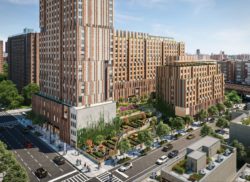
Rendering of Sendero Verde. Image Credit: HPD/Handel Architects
The project will be financed under an HPD program that requires low and extremely low-income affordability and set-asides for the formerly homeless. On June 27, 2019, the Department of Housing Preservation and Development (HPD), the Housing Development Corporation (HDC,) L+M Development Partners, Jonathan Rose Companies, and Acacia Network announced finalized plans for the first stage of development of Sendero Verde in East Harlem in Manhattan. The site is located on 111th Street, bounded by 112th Street, Park Avenue, and Madison Avenue. The $223 million first phase of the project will be 100 percent affordable and will include 361 residential units, a new school, and an 18,000 square-foot publicly accessible courtyard featuring a children’s play area, seating areas, adult outdoor exercise equipment, and a stage for community events.
Currently, the property is vacant. The Department of Parks and Recreation’s Green Thumb program is coordinating with the developers to relocate community garden groups that inhabited the vacant lot until 2018. Construction of the first phase is expected to begin in the coming weeks and is projected to end in 2022.
Phase two of Sendero Verde will include approximately 350 additional 100 percent affordable housing units that serve a variety of income brackets.
At the completion of both phases, the project will provide over 700 units of affordable housing, publicly accessible open space, community gardens, community and social service space, a school, and neighborhood retail. Handel Architects designed Sendero Verde.
Sendero Verde will meet Passive House efficiency standards. Sendero Verde is expected to use 60-70% less energy than similar buildings by incorporating green space, gardens, air-tight construction methods to reduce draft and energy loss, triple-glazed windows, mechanically ventilated spaces with energy recovery, and individually heated and cooled units.
The developers have collaborated with Promesa, an affiliate of Acacia Network, to provide social services for the project’s formerly homeless population. Promesa’s program will include access to a resident social services director, occupational therapists, housing specialists, case managers, art and dance classes, and twenty-four hour security. Promesa’s program will be given 2,700 square feet of space within Sendero Verde which will include eight private offices, a medical exam room, and a conference room.
HPD and HDC financed the $223 million first phase of the project with construction loans, Resolution A funding from the City Council, and grant funding from New York State Energy Research and Development Authority (NYSERDA). Bank of America supplemented funding with a letter of credit, a syndication of federal low-income housing tax credits and solar investment tax credits, and New York State Brownfield Tax Credits. HDC contributed $120 million in bond financing and subsidy to the first phase the project.
The first phase of Sendero Verde is financed by HPD’s and HDC’s Extremely Low & Low-Income Affordability (ELLA) program. The ELLA program creates new homes for extremely low-, very low-, and low-income households, and is affordable to New Yorkers earning a range of incomes. Thirty-six inits in Sendero Verde with additional supportive services will be set aside for formerly homeless families through the Mayor’s NYC 15/15 initiative.
By: Laine Vitkevich (Laine is a CityLaw Intern and New York Law School student, Class of 2020)


1. Extremey bad public policy to destroy greenspace. A better policy would be an “Anti-Warehousing” law which requires all units of RS housing which are vacant for 90 days to be used fot affordable public housing. Americans must learn to care for haousing stock in existence and utlize it wisely, not expand the built environment.
2. L+M is notorious and the City should not do business with this developer/landlord. Some poliicians have given back money donated by its affiliates.
3. So called affordable housing is often a 421-a scam based upon tax subsidies, asset appreciation during the rent stabilized phase and a legal loophole allowing for deregulation. Close the 421-a loophole.
4. Reocation of community gardedn is a euphamism for sanctioned sprawl and reflects the City Planning office genuflecting to developer’s interests. In an age of ecocide it is wrong to bulldoze the green commons.
5. Follow the money for campaign dollars and see if it supports the neoliberal agenda of privatization. All this new construction is another name for publicly subsizied eventual privatiization.
You said everything that i been say. I applied for many low-mid housing lotteries and its always not enough of money or you just dont qualify. If i could tell you some things
Who can i contact for an application?
3 years later update:
1. Greenspace destroyed.
2. Much noise, pollution road obstruction. Carbon release is off the scale. This is an act of ecocide.
3. East Harlem has not benefited in anyway.
4. The tentacles of L+M continue to such tax giveaway money for private benefit, especially as L+M continues to kill off Section 9 in Harlem and strangle black and brown tenants by taking away their rights once they have Section 8 crammed down their throats.